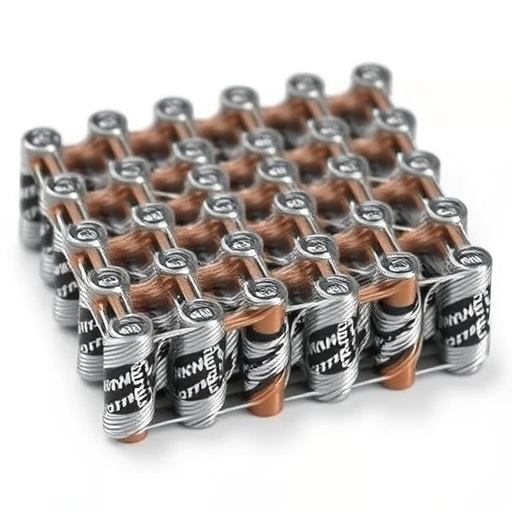Recent advances in energy storage have been propelled by the quest for efficient and affordable supercapacitor materials. A pioneering study has brought to light an innovative nanocomposite, the g-C₃N₄/NiMn layered double hydroxide, which showcases promising properties for use in supercapacitors. This development could mark a significant leap toward enhancing energy storage solutions critical for a sustainable future. The relevance of this research transcends mere academic curiosity, as it directly addresses the global demand for efficient energy storage systems in various technological applications, from portable electronics to renewable energy integration.
The researchers behind this breakthrough, G. Sivasankari, D. Prabha, and P. Atheek, employed an in-situ synthesis method to produce the g-C₃N₄/NiMn nanocomposite. This technique not only ensures that the structural integrity of the composite is maintained but also optimizes the distribution of the nanomaterials, enhancing electrochemical performance. The in-situ approach allows for uniform interaction between the components, leading to improved conductivity and overall energy storage capabilities.
Layered double hydroxides (LDHs) have garnered attention due to their tunable properties and high surface area. By integrating g-C₃N₄ with NiMn, the researchers have engineered a composite that leverages the strengths of both materials. The g-C₃N₄ acts as a support scaffold, promoting the stability of the nickel-manganese hydroxide, which is a well-known supercapacitor material. This synergy between the two components results in a composite that exhibits enhanced capacitance and cycle stability, making it a formidable candidate for next-generation energy storage devices.
Electrochemical characterization of the g-C₃N₄/NiMn layered double hydroxide nanocomposite reveals remarkable performance metrics. The composite demonstrates a high specific capacitance, far exceeding that of traditional capacitance materials. This remarkable performance can be attributed to the unique layered structure of the composite, which facilitates ion transport and enhances charge storage mechanisms. Additionally, the researchers report impressive cycle stability, a crucial factor for practical applications, as it indicates the material’s ability to maintain performance over repeated charge and discharge cycles.
One of the standout features of this nanocomposite is its exceptional energy density, a critical parameter that determines the efficiency of supercapacitors. The combination of g-C₃N₄ and NiMn enhances the energy storage capabilities of the device, ensuring higher performance outputs. This is particularly significant for high-demand applications, such as electric vehicles and large-scale energy storage systems, where efficiency and longevity are paramount to success.
The research further delves into the morphological and structural properties of the synthesized nanocomposite. Through advanced characterization techniques, including X-ray diffraction and scanning electron microscopy, the authors confirm the successful synthesis of the g-C₃N₄/NiMn composite. These analyses provide insights into the crystalline structure, surface morphology, and particle size distribution, all of which are essential for understanding how these factors influence the electrochemical performance.
Moreover, the study’s findings hold promise for integration into existing energy storage technologies. The versatility of the g-C₃N₄/NiMn nanocomposite lends itself well to various configurations, whether as standalone supercapacitors or in hybrid systems alongside batteries. This flexibility positions the composite as a valuable asset in the ongoing evolution of efficient energy storage architectures that bridge the gap between rapid power delivery and sustainable energy management.
The growing demand for sustainable energy solutions underpins the urgency of this research. With rising environmental concerns, the need for renewable energy technologies is greater than ever. Supercapacitors, with their rapid charge and discharge capabilities, are increasingly being identified as pivotal components for energy management in renewable systems such as solar and wind energy. The introduction of the g-C₃N₄/NiMn nanocomposite may serve to align supercapacitor technology with broader energy sustainability goals, providing a pathway towards greener energy solutions.
Furthermore, researchers highlighted the potential for scalable production of the nanocomposite. The synthesis methodology described in the study is not only efficient but also has the potential for easy scale-up, which is vital for commercial viability. This aspect of the research could lead to widespread adoption of the material in various industries, thereby impacting energy storage technology on a global scale.
In conclusion, the advent of the g-C₃N₄/NiMn layered double hydroxide nanocomposite marks a significant milestone in supercapacitor research. By synthesizing this innovative material with in-situ methods, the researchers have developed a composite that excels in performance, stability, and potential for scalability. This research not only contributes to the academic understanding of nanocomposites but also to the practical advancements in energy storage solutions, positioning it as a vital development in the ongoing narrative of energy technology evolution.
As we move forward into an era defined by energy efficiency and sustainability, the innovations reflected in this research will undoubtedly play a crucial role. The synergy between materials science and energy technology is paramount in addressing the challenges of the modern age. With studies like this illuminating the path ahead, the future of energy storage appears bright, promising new solutions that are not only efficient but also environmentally conscious.
These advancements invite further exploration, collating insights from various fields towards the common goal of delivering innovative energy solutions. As the scientific community continues to innovate, the implications of such research extend far beyond the laboratory, shaping the strategies we adopt in the quest for sustainable energy.
Subject of Research: Development and performance evaluation of g-C₃N₄/NiMn layered double hydroxide nanocomposite for supercapacitor applications.
Article Title: In-situ g-C₃N₄/NiMn layered double hydroxide nanocomposite for supercapacitor application.
Article References:
Sivasankari, G., Prabha, D., Atheek, P. et al. In-situ g-C3N4/NiMn layered double hydroxide nanocomposite for supercapacitor application. Ionics (2025). https://doi.org/10.1007/s11581-025-06728-w
Image Credits: AI Generated
DOI: https://doi.org/10.1007/s11581-025-06728-w
Keywords: Supercapacitor, g-C₃N₄, NiMn, layered double hydroxide, nanocomposite, energy storage, electrochemical performance, sustainability.
Tags: advanced supercapacitor materialsconductivity improvement in energy systemselectrochemical performance enhancementEnergy Storage Solutionsg-C3N4 NiMn nanocompositein-situ synthesis techniquesinnovative materials for supercapacitorslayered double hydroxides applicationsportable electronics energy storagerenewable energy integration solutionssustainable energy technologiestunable properties of nanocomposites





